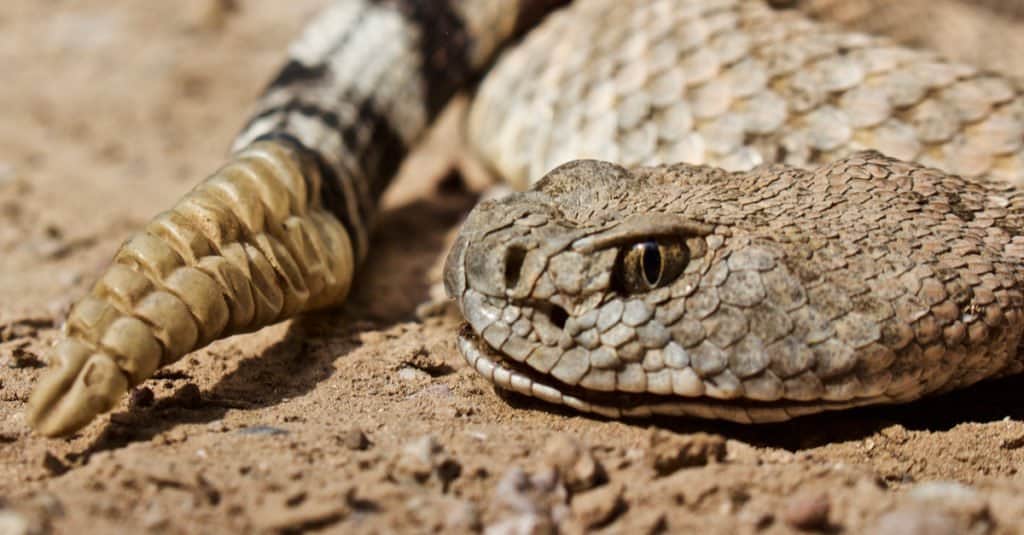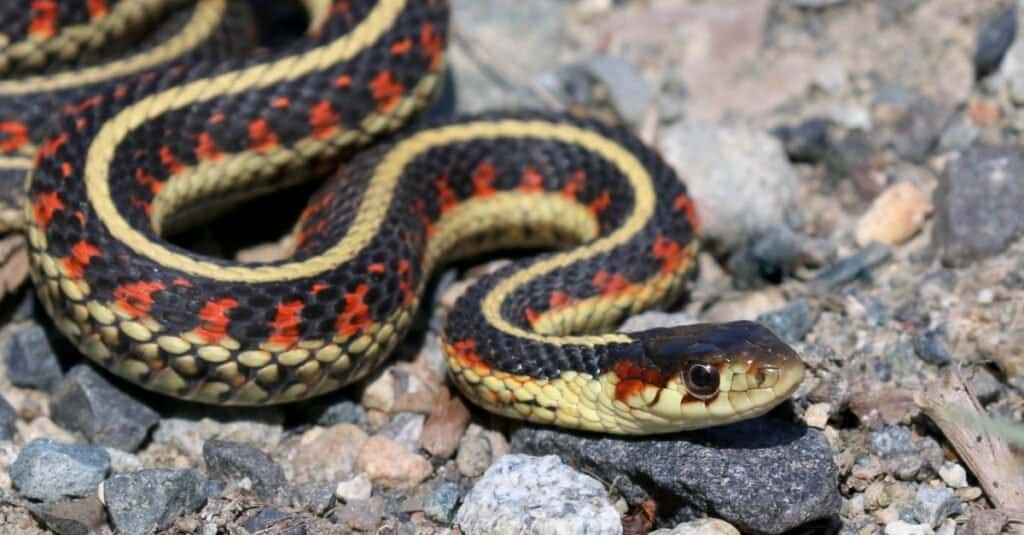More than 25 species of snakes live in Canada. They are found everywhere except in Labrador, Newfoundland, Nunavut, and Yukon. Twelve of these species are listed by COSEWIC as being at risk of extinction. Three species are considered extirpated due to their recent isolated populations.
Canada’s snakes are non-aggressive and mostly shy. They tend to avoid encounters with humans as much as possible. You are more likely to hear their rustling sounds as they slither through vegetation. However, like most creatures, all snakes bite in self-defense whenever provoked or cornered.
Here is the largest snake found in Canada!
What is the Largest Snake Found in Canada?

The gray rat snake is Canada’s largest snake species.
©dkHDvideo/Shutterstock.com
The gray rat snake (Pantherophis spiloides) is Canada’s largest snake species. It’s listed federally as an endangered and threatened species in the country. An adult gray rat snake is about 39-72 inches (99-183 cm), though it may reach a maximum snout-vent length of 255 cm. The juveniles measure around 13 inches (33 cm) from nose to tail.
Gray rat snakes vary from slender to stocky body shapes, with weakly keeled scales and divided anal plates. Mature gray rat snakes exhibit different color pattern variations. They are technically plain, shiny black with red, orange, yellow, or white colorations on their skin between the scales. The young ones are dorsally patterned and have a pale gray background with dark gray spots.
Where is the Gray Rat Snake Found in Canada?
The gray rat snake is commonly found in two geographically disjunct regions in southwestern Ontario and southeastern Ontario, where they inhabit various woodland habitats across their range.
Gray rat snakes hibernate below ground in hibernacula in winter. They prefer open habitats like rock crevices, hollow logs, and standing snags during the active seasons (May-September).
Females become sexually mature at 7-9 years of age. They lay between 5 and 27 eggs in compost piles, logs, stumps, and standing snugs where temperatures are appropriate for incubation. Eggs hatch in about two months.
Is the Gray Rat Snake Dangerous?

Gray rat snakes are not dangerous to humans or pets.
©Gabbie Berry/Shutterstock.com
Gray rat snakes are not dangerous to humans or pets. They are not aggressive and always avoid direct contact with people. However, they can bite when provoked. When startled, the gray rat snake remains motionless, holding its body in a series of wave-like kinks. It makes audible buzzing sounds and rattles its tail against whatever it’s lying on whenever approached.
The gray rat snake raises its head and bluffs a strike in self-defense. It musks the victim with foul-smelling contents from its cloaca if handled, only biting if necessary. But this snake typically calms down quickly if held.
What Happens if a Gray Rat Snake Bites You?
Gray rat snakes are non-venomous and often kill their prey by constriction. Their bite is not fatal but rather painful. The wound will require a small bandage and treatment against secondary bacterial infections because bites from gray rat snakes are full of bacteria that can harm you.
Do Gray Rat Snakes Have Predators?

Gray rat snakes are vulnerable to predation by foxes, egrets, owls, raccoons, and hawks.
©iStock.com/emkaplin
Gray rat snakes are vulnerable to predation by foxes, egrets, owls, raccoons, and hawks. These predators find it easy to attack the gray snakes because they are non-venomous. Birds of prey scoop up these snakes while sunning or resting in exposed areas.
Other snakes like the black racers, cottonmouth, and king snakes feed on baby gray snakes and eggs. Large birds of prey and other animals often take advantage of gray rat snakes since they are docile reptiles.
What Does The Gray Rat Snake Eat?
The diet of gray rat snakes consists of rodents, frogs, lizards, and small birds. They are obligate carnivores that only eat other animals. Gray rat snakes often swallow small prey alive and constrict larger prey by coiling their body. Juveniles prefer lizards and frogs.
How Does the Diet of the Gray Rat Snake Impact Other Species?
Gray rat snakes are incredibly beneficial, both as predators and prey. They help manage the rodent population by consuming rats, voles, and mice, which are considered pests by humans. In turn, gray rat snakes are also food for many bird and animal species.
What Other Snakes Are Found in Canada?
There are several other harmless snakes in Canada. So far, only three people have died from rattlesnake bites in the country, the last being more than 40 years ago. The following are six snakes that can be sighted in Canada.
1. Prairie Rattlesnake

Prairie rattlesnakes are found in foothills, plains, and arid environments across the country.
©DMartin09/Shutterstock.com
The Prairie rattlesnake (Crotalus viridis) is a venomous pit viper native to southwestern Canada. This shake occurs in foothills, plains, and arid environments across the country. You can also find a prairie rattlesnake in a wooded area with easy access to sunshine, food, and places to hide from predators.
Prairie rattlesnakes grow to more than 3.3-4.87 ft (100-151. 5 cm) in length. They are lightly colored with dark-brown spots distributed in a dorsal pattern. They also have a distinctive color band at the back of the eye.
2. Common Garter Snake

The common garter snake inhabits forests, meadows, marshes, prairies, wetlands, and forests.
©iStock.com/randimal
Common garter snakes (Thamnophis sirtalis) are a natricine snake species commonly found in Canada. They inhabit the forests, meadows, marshes, prairies, wetlands, and forests. They are not very dangerous to humans, though their bites may cause itching, burning, or swelling. Their bites are only toxic to small animals, especially amphibians.
Common garter snakes are skinny snakes that grow up to 18-42 inches, and most stay smaller. They have many different color patterns with longitudinal stripes. They come in orange, blue, red, yellow, gold, black, and brown.
3. Massasauga Rattlesnake

The massasauga rattlesnake is a highly venomous species of rattlesnake found in southern Ontario.
©Ryan M. Bolton/Shutterstock.com
The massasauga rattlesnake (Sistrurus catenatus) is a highly venomous species of rattlesnake found in southern Ontario. It is located primarily on the Bruce Peninsula and along the eastern side of Georgian Bay.
Massasauga rattlesnakes are 24-34 inches (60-75 cm) in length. The juveniles are well-patterned but paler than the adults. They are gray with black or brown marks down the center of the back. Their anal scales are single, while the rest of the scales are keeled.
4. Ribbon Snake

The ribbon snake prefers to inhabit marine and high vegetation areas like lakes, streams, and marshes.
©iStock.com/sdbower
Ribbon snakes (Thamnophis saurita) are among the species of garter snake found in Canada. They prefer to inhabit marine and high vegetation areas like lakes, streams, and marshes. They live in areas near water bodies because they feed on ectothermic animals.
Ribbon snakes are 18-35 inches (43-89 cm) in length. They are dark brown with yellow striped bodies. They are non-venomous species of snakes. Ribbon snakes rarely use any aggressive forms of defense.
5. Bullsnake

Bull snakes are often sighted within Alberta, where they inhabit the mixed grassland region in Milk River valleys.
©Markparker1983/Shutterstock.com
The bull snake (Pituophis catenifer sayi) is a large non-venomous snake found in Canada. Bull snakes are often sighted within Alberta, where they inhabit the mixed grassland region in Milk river valleys, South Saskatchewan, and the lower Red Deer.
Adult bullsnakes are 4-8 ft (1.2- 2 m) in length. They exhibit many color variations but are usually yellow with red, black, white, or brown blotching. They are non-venomous despite their menacing attitude. So, they are not perceived as serious threats to people and pets.
6. Eastern Hognose Snake

Eastern hognose snakes are often considered non-venomous because they are not harmful to people and pets.
©IHX/Shutterstock.com
Eastern hognose snakes (Heterodon platirhinos) are rear-fanged, mildly venomous snakes native to eastern North America from southern Canada. They inhabit the woodlands with farmland, fields, and loose sandy soil for burrowing purposes.
Eastern hognose snakes measure one to three and a half feet in length and females are larger than males. They can be brown, orange, green, red, gray, or black with cream, yellow, or gray bellies. They can also be patternless, checkered, or blotched. The eastern hognose snakes are often considered non-venomous because they are not harmful to people and pets.
The photo featured at the top of this post is © dkHDvideo/Shutterstock.com
Discover the "Monster" Snake 5X Bigger than an Anaconda
Every day A-Z Animals sends out some of the most incredible facts in the world from our free newsletter. Want to discover the 10 most beautiful snakes in the world, a "snake island" where you're never more than 3 feet from danger, or a "monster" snake 5X larger than an anaconda? Then sign up right now and you'll start receiving our daily newsletter absolutely free.
Thank you for reading! Have some feedback for us? Contact the AZ Animals editorial team.






